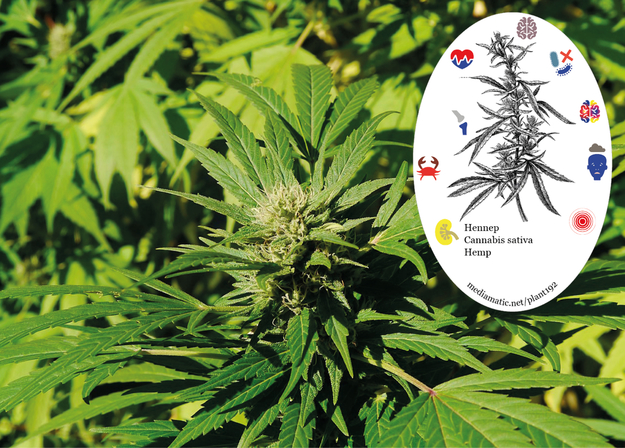Hemp, or more appropriately cannabis since the form grown for fibre contains much less of the medicinally active compounds, has a very long history of medicinal use, though it is illegal to grow in many countries since the leaves and other parts of the plant are widely used as a narcotic drug. The leaves and the resin that exudes from them are the parts mainly used, though all parts of the plant contain the active ingredients. Cannabis contains a wide range of active ingredients, perhaps the most important of which is THC. The principal uses of the plant are as a pain-killer, sleep-inducer and reliever of the nausea caused by chemotherapy, whilst it also has a soothing influence in nervous disorders. Although cannabis does not effect a cure for many of the problems it is prescribed to treat, it is a very safe and effective medicine for helping to reduce the symptoms of many serious diseases. For example, it relieves the MS sufferer of the distressing desire to urinate, even when the bladder is empty. As long as it is used regularly, it also greatly reduces the pressure in the eye to relieve the symptoms of glaucoma. The whole plant is anodyne, anthelmintic, antiemetic, anti-inflammatory, antiperiodic, antispasmodic, cholagogue, diuretic, emollient, hypnotic, hypotensive, laxative, narcotic, ophthalmic and sedative. It is used to relieve some of the unpleasant side effects suffered by people undergoing chemotherapy for cancer - in particular it is very effective in removing the feelings of nausea and indeed helps to create an appetite and positive attitude of mind which is so important to people undergoing this treatment. It has also been found of use in the treatment of glaucoma and relieves the distressing constant desire to urinate that is suffered by many people with multiple sclerosis. Given to patients suffering from AIDS, it helps them to put on weight. Since it strongly increases the desire for food it has been found of benefit in treating anorexia nervosa. It is used externally as a poultice for corns, sores, varicose veins, gout and rheumatism. Few plants have a greater array of folk medicine uses. Cannabis has been used in the treatment of a wide range of conditions including alcohol withdrawal, anthrax, asthma, blood poisoning, bronchitis, burns, catarrh, childbirth, convulsions, coughs, cystitis, delirium, depression, diarrhoea, dysentery, dysmenorrhoea, epilepsy, fever, gonorrhoea, gout, inflammation, insomnia, jaundice, lockjaw, malaria, mania, menorrhagia, migraine, morphine withdrawal, neuralgia, palsy, rheumatism, scalds, snakebite, swellings, tetanus, toothache, uteral prolapse, and whooping cough. The seed is anodyne, anthelmintic, demulcent, diuretic, emollient, emmenagogue, febrifuge, laxative, narcotic and tonic. It is used to treat constipation caused by debility or fluid retention. The seed is an important source of essential fatty acids and can be very helpful in the treatment of many nervous diseases. A high content of very active antibacterial and analgesic substances has been found in the plant. It has bactericidal effects on gram-positive micro-organisms, in some cases up to a dilution of 1:150,000. Source: https://pfaf.org/
Hemp
Cannabis sativa
Find more about this plant on Wikipedia.
